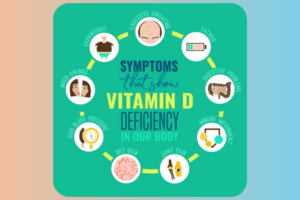
Can Vitamin D Deficiency Cause Headaches? Yes.
October 25, 2024
Can Deficiency of Vitamin D Cause Headaches?
The Relationship Between Vitamin D and Headaches
Recent studies have been able to establish that a deficiency in Vitamin D affects over 40% of the world’s adults and is responsible for health conditions other than bone disorders, such as immune and neurological conditions. There is an emerging body of research evidence that Vitamin D deficiency may also contribute to increasing headache frequency by pointing out the diverse functions this vitamin plays.
But does the lack of vitamin D in itself contribute to headaches? Considering how this vitamin is supposed to play a role in the way the brain works, including the way nerves communicate and moods are regulated, it’s quite easy to believe low levels can contribute to headaches, possibly affecting those people that suffer from migraines or chronic headache victims.
How Vitamin D Deficiency Works

Vitamin D’s Essential Functions
Vitamin D is important not just to maintain bone strength but also for immune response, mood stability, and mental health. It promotes calcium absorption, which is necessary for normal musculature and nervous system functioning, preventing spasms or tension that can trigger headaches. Aside from these, vitamin D enhances neurotransmitter activity in the brain and contributes to mood and energy level balance.
Common Symptoms of Vitamin D Deficiency
Most Vitamin D deficiency presents asymptomatically, but when symptoms do appear, they are often a combination of the following: Fatigue or general low energy Muscle ache or cramps Mood changes, which can include feelings of depression Brain fog or mental tiredness
These symptoms, especially foggy brain and mood swings, highlight the ability of the deficiency to implicate neurological health, which could also be responsible for headaches. The symptoms are usually so subtle that many people will not know they have a deficiency until they begin developing some major health effects.
Factors which Contribute to a Deficiency
There are many factors which contribute to the risk of a deficiency in vitamin D, and for that reason it is more common than most people realize:
- Poor Sun Exposure: Those individuals who always stay indoors, or live in areas where the level of sunlight is not sufficient, may have lower natural production of vitamin D.
- Dietary: Since very few foods contain vitamin D naturally, those individuals who limit their diets or are vegans may not get enough sources from their diet.
- Health Conditions: Impaired absorption of Vitamin D, due to conditions like Crohn’s disease and celiac disease, can increase the chances of deficiency.
All these above factors might have a very strong impact on one’s vitamin D levels, thus possibly resulting in headaches or other symptoms due to low levels.
How Vitamin D Deficiency Can Cause Headaches
Possible Biological Mechanisms
Low vitamin D levels might influence inflammation within the body-a process often associated with headaches. Without sufficient vitamin D, this may enhance this inflammatory response and act as a trigger or worsening factor in headache disorders. Vitamin D also regulates calcium, an element integral to normal transmission between nerves. When that is off balance, it may act as a trigger toward migraine susceptibility, given the fact that impaired calcium signaling may result in overactive nerves or muscle tension, one of the most common headache triggers.
Hormonal and Mood-Related Connections
Vitamin D also regulates hormones, including serotonin and endorphins. These neurotransmitters play a crucial role in maintaining mood and modulating pain. A deficiency in vitamin D might decrease the levels of serotonin or endorphins; therefore, it can be one of the potential causes of changes in mood and the propensity toward headaches. This is particularly relevant in migraine patients, where fluctuations in serotonin have been noted to influence migraine frequency and severity.
Inflammation and Chronic Headaches
It is believed that chronic headaches among persons with low levels of vitamin D are related to inflammation. Inflammatory cytokines may affect blood flow and the pain pathways in the brain, with increased levels accompanying deficiency. A trend observed in some studies points out that recurrent headache sufferers usually have lower vitamin D levels, which can underscore the possible role of chronic inflammation in headache patterns.
Case Studies and Research Regarding Vitamin D Deficiency Causing Headaches
Evidence-Based Studies
Researches into the relation between a lack of vitamin D and headache are really enlightening. Among them, a very important study reported in 2020 stated that the vast majority-94.9%-of the patients with migraine had inadequate levels of vitamin D. Thus, the above correlation infers a strong relationship between the levels of vitamin D and headache prevalence. The study points toward supplementation of vitamin D as one potential approach toward management of headaches related to deficiency. Read more in this study.
How to Address Vitamin D Deficiency

Dietary Sources of Vitamin D
The most straightforward approach is often an increase in vitamin D through one’s diet. Foods that contain vitamin D will include the following :
- Salmon, along with other kinds of fatty fish
- Fortified milk and dairy products
- Egg yolks
The recommended daily intake varies, but for most adults, 600-800 IU or International Units per day is often given. Inclusion of these foods into the diet in the right proportion can help to maintain optimum levels of vitamin D and may prevent deficiency-related headaches.
Supplementation of Vitamin D
This is surely the way for supplementation in those who can’t get enough from their diet or sunlight. The normally recommended vitamin D supplement is Vitamin D3, at dosages of 1,000 to 2,000 IU daily. A person ought to consult a healthcare professional before starting supplementation-particularly because vitamin D might be interacting with other vitamins and minerals.
IV Therapy’s Role in Treating Deficiency
IV therapy is an effective and fast treatment to replenish low levels of vitamin D directly into the bloodstream. It really helps people who have diseases involving malabsorption or severe deficiency. At Uplift IV Wellness, customized IV therapy solutions make sure you get the proper amount of Vitamin D to boost your energy instantly and help in general wellness in an easy, accessible way.
Vitamin D is at the Forefront in Headache Prevention.
Overview of the Major Points
It has been linked to a wide range of health problems and increased headache risks. Low vitamin D has been associated with headache promotion through increased inflammation, impaired calcium regulation, and changes related to mood. Dietary management, supplementation, and even IV therapy might reduce frequency by addressing deficiencies.
If you are one of those people who always have headaches, you should consider getting tested for vitamin deficiencies in vitamin D. Increasing your levels may be your first step to relief. Discover how Uplift IV Wellness can help you tailor an approach to your individual needs in vitamin D support as part of your wellness plan with their IV therapy options – contact us today for your next mobile iv therapy appointment.